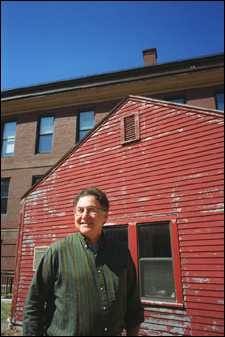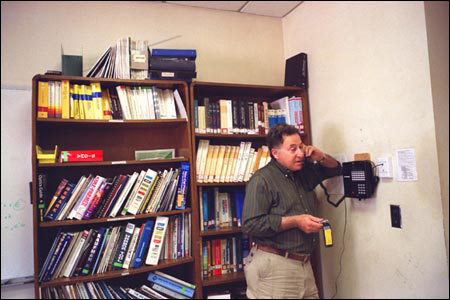Shed no tears
Small home to big discoveries is gone
By their nature, sheds are small and unpretentious structures, typically built for storing lawnmowers and shovels and such. The red shed that had been affixed

to the side of Lyman Laboratory of the Department of Physics for almost 70 years appeared to be no different – a minor wood building that seemed uncomfortably out of place next to the far more substantial Lyman, which was built out of brick and mortar in 1931.
Yet the shed’s appearance belied the important role it played in 20th century physics. More descriptively called the “cosmic-ray shed,” it was the setting for some great scientific discoveries. But on May 25, the cosmic-ray shed took part in its final physics experiment: inertia. The shed met the force of a bulldozer to make room for the new Laboratory for Interface Science and Engineering (LISE) being built adjacent to the Gordon McKay Laboratory.
Robert Pound, Mallinckrodt Professor of Physics Emeritus, was working in the shed with Edward Mills Purcell in 1945 when nuclear magnetic resonance (NMR) was first observed. NMR is the basis of magnetic resonance imaging (MRI), which turned out to be a revolutionary diagnostic tool to produce images of the inside of the body. Purcell’s research with NMR earned him the Nobel Prize in 1952 (along with Felix Bloch from Stanford).
“Although initially thought about as an aspect of the then-frontier subject of nuclear physics,” Pound said, “NMR soon became the basis of innumerable applications in condensed matter physics, chemistry, biology, and finally MRI.”

But NMR wasn’t the first important finding within the shed’s walls. In fact, its very construction was to aid experiments impossible inside the heavy brick buildings of the Physics Department. “The shed was built for Jabez Curry Street for his cosmic-ray research in the middle 1930s, probably about 1935,” Pound said. “It was built to provide a path for cosmic rays into his ‘cloud chambers’ in a lower density [building] than [was] available in the masonry laboratory adjacent.”
Street is credited with identifying the mass and decay time of the muon (formerly called the mu meson) in the shed. A muon is an unstable subatomic particle similar to an electron that breaks down quickly into an electron and two types of neutrinos. Before decaying, muons lose energy by knocking electrons out of atoms (ionization). Traveling at close to the speed of light, muons in cosmic rays are extremely penetrating and can travel thousands of feet below the Earth’s surface.
Pound said it was Street’s unselfishness that helped them to subsequently detect NMR at Harvard. At the time, Purcell and Pound were working for M.I.T. when Street offered them use of the shed for their experiments. “Curry’s lab hadn’t been occupied for some five years and was full of cobwebs,” Pound said. “So we spent some time reactivating it. This began in November of 1945. Our experiment was successful on December 15, 1945.”
Purcell and Pound officially came over to Harvard in July of 1946, and the new versions of NMR experiments moved to Lyman. The shed then became a storage space, and withstood occasional floods from frozen water pipes.
When Isaac Silvera, the Thomas D. Cabot Professor of the Natural Sciences, arrived at Harvard in 1982, the shed was in bad shape. It was unheated and leaked. But in 1990, it was renovated, and was used by Silvera’s research group as a meeting room, library, and small lab until its demolition.
“The cosmic-ray shed has been an important part of my research group for more than a decade,” Silvera said. “It was once allowed to decay to a decrepit state, but was beautifully renovated. We will miss the cozy area where we often gathered and where many new ideas have been fostered, perhaps stimulated by the echoes of giants who formerly occupied it.”




